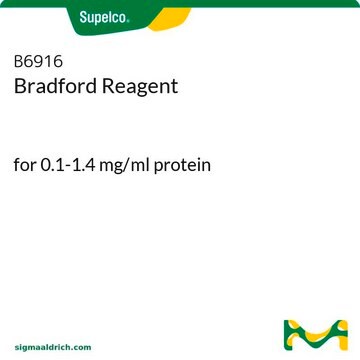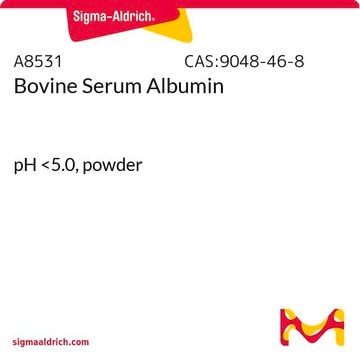1.15444
Coomassie Brilliant blue G 250 (C.I. 42655)
for electrophoresis
Sinônimo(s):
Coomassie Brilliant blue G 250 (C.I. 42655), Acid blue 90, Brilliant Blue G, Cyanine G, Polar Blue G, SERVA BLUE G, protein gel stain
About This Item
Produtos recomendados
Nível de qualidade
potência
>5000 mg/kg LD50, oral (Rat)
técnica(s)
protein staining: suitable
pH
6.4 (20 °C, 10 g/L in H2O)
solubilidade
40 g/L
densidade volumétrica
520 kg/m3
temperatura de armazenamento
no temp limit
cadeia de caracteres SMILES
[Na+].[S](=O)(=O)([O-])c1cc(ccc1)CN(CC)c2cc(c(cc2)[C+](c5c(cc(cc5)N(CC)Cc6cc(ccc6)[S](=O)(=O)[O-])C)c3ccc(cc3)Nc4ccc(cc4)OCC)C
InChI
1S/C47H49N3O7S2.Na/c1-6-49(31-35-11-9-13-43(29-35)58(51,52)53)40-21-25-45(33(4)27-40)47(37-15-17-38(18-16-37)48-39-19-23-42(24-20-39)57-8-3)46-26-22-41(28-34(46)5)50(7-2)32-36-12-10-14-44(30-36)59(54,55)56;/h9-30,48H,6-8,31-32H2,1-5H3,(H-,51,52,53,54,55,56);/q;+1/p-1
chave InChI
CMGWKYXJIYYESN-UHFFFAOYSA-M
Descrição geral
Aplicação
Nota de análise
Absorption maximum λmax. (buffer pH 7.0): 577 - 584 nm
Spec. Absorptivity A 1%/1cm (λmax; 0.01 g/l; buffer pH 7.0; calc. on dried substance): 450 - 570
TLC-Test: passes test
Loss on drying (110 °C): ≤ 8 %
Suitability for electrophoresis: passes test
Informações legais
Código de classe de armazenamento
11 - Combustible Solids
Classe de risco de água (WGK)
WGK 3
Ponto de fulgor (°F)
Not applicable
Ponto de fulgor (°C)
Not applicable
Certificados de análise (COA)
Busque Certificados de análise (COA) digitando o Número do Lote do produto. Os números de lote e remessa podem ser encontrados no rótulo de um produto após a palavra “Lot” ou “Batch”.
Já possui este produto?
Encontre a documentação dos produtos que você adquiriu recentemente na biblioteca de documentos.
Os clientes também visualizaram
Artigos
Identify causes and remedies for SDS-PAGE sample preparation challenges and optimize electrophoresis conditions.
Active Filters
Nossa equipe de cientistas tem experiência em todas as áreas de pesquisa, incluindo Life Sciences, ciência de materiais, síntese química, cromatografia, química analítica e muitas outras.
Entre em contato com a assistência técnica







